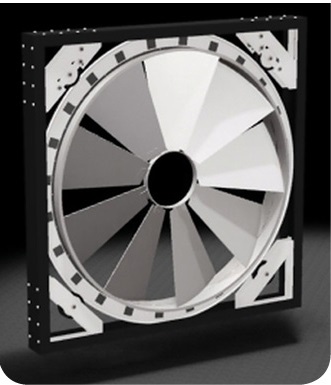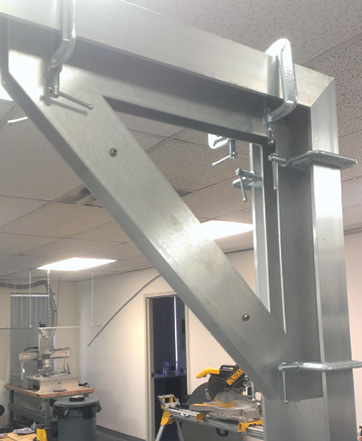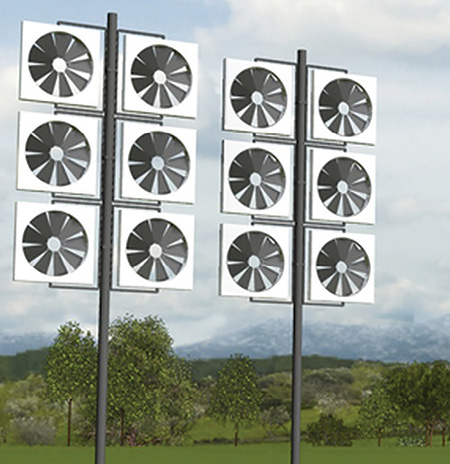An unusual wind turbine design supports a rotor of about nine blades along with generator elements on a large rim that rolls on wheels fixed to a frame. The design provides a range of advantages, such as power production in winds up to 110 mph. R&D went well, but manufacturing proved a bit troublesome. “The wind turbine frame is square and made of a heavy, structural-aluminum “U” channel,” says inventor and Wind Power Cube CEO Daniel Morrison. “To secure the channels, we had to attach large angle brackets in each corner. Some units are quite large, up to 6-ft, 8-in. on a side.”
Morrison’s team considered welding, bolting, and adhesives to secure the bracket to the frame. Each option caused production headaches. “For instance, we initially bolted the brackets to frames. While this was adequate for testing, it was inadequate for final production,” he says.
The frame is subject to strong winds that place a twisting load between adjacent sides. Bolting the large dual brackets in each corner let the frame twist as the brackets slid within the hole tolerances. The movement also presented long-term hole elongation and bolt shear issues. Because the turbines are an outdoor product, bolt movement makes it difficult to seal the holes letting moisture enter the structure.
“We can’t use aluminum bolts in the aluminum frame because the bolts are not be strong enough,” explained Morrison. “So we considered stainless steel bolts, but then you run into the problem of galvanization between the two metals.”
Another design feature caused headaches. “The turbine rotor uses a stainless steel circular mount that rotates. To support the rotor, stainless steel tubing must attach to the outermost edge of the rotor blades. The tubing forms a track that rotates in the supporting wheels.”
“We tried to weld the tubing to the circle, but the tubing is so thin, welding melted it,” Morrison said. “To avoid that, the weld had to be long – almost 18-ft around – and we had to weld both sides of the tubing. Not only was this process labor intensive and costly, it took a big part of a day just to weld one piece of tubing.”
Morrison then became interested in the possibility of using an adhesive to bond the brackets and tube. His team selected a two-component structural adhesive used in automotive assembly. “It failed miserably,” says Morrison. “So badly we almost gave up on the idea of using an adhesive. Suddenly we weren’t sure how we would be able to manufacture our product.”
Morrison continued his search for an adhesive believing it would be the best solution, if an adequate formula could be found. Working with a distributor of LORD adhesives, Morrison decided to try LORD 406/19GB gray acrylic adhesive. A sample of the adhesive performed beyond expectations.
“Considering the bad experience with the first adhesive attempt, we were not expecting much in the way of positive results,” he says. “The LORD distributor, Krayden, Inc., assessed our problems and recommended the acrylic adhesive Maxlok.”
Bob Wilson, technical sales with the distributor, helped Morrison to focus on adhesives as a possible solution to Wind Power Cube’s bonding problems. “We were able to provide the technical expertise needed for them to feel comfortable with using an adhesive,” said Wilson.
He added that LORD acrylic adhesives can replace welding, brazing, riveting, and other mechanical fastening methods over a wide temperature range and environments subject to high impact or high peel loads. The adhesives bond to a variety of unprepared metals with minimal substrate penetration. Due to its content of glass beads, the adhesive allows precise control of bondline thickness. Non-sagging properties let the adhesive stay in position when applied on vertical or overhead surfaces.
The adhesive now lets Morrison’s crew build large frames rapidly. Assembly technicians just put a couple of beads of adhesive on the brackets and clamp them into the corners. By the next day, the bonded pieces are as “solid as a rock.” The adhesive is extremely strong – “we can do chin-ups on a frame – and it’s stronger than welding,” said one assembler.
Pricing was another plus. “The first adhesive that failed was costly,” says Morrison. “In addition to better performance properties, the Lord adhesive is almost one-quarter the price.”
With support from the distributor, Wind Power Cube is considering upgrading its production line process. Although workers are now using handheld cartridges to apply the adhesive, they are exploring alternative application methods, such as pneumatic guns. They are also considering an automatic meter, mix, and dispensing equipment, which would fit in well with the company’s production methods. WPE
Turbine in a box
The developer of an unusual wind turbine thinks his design solves a few wind industry problems. Engineers at Wind Power Cube Inc., Chantilly, Virginia, have designed a modular wind turbine that is self-contained in a square frame. The innovative shape and axle-less design safely generates energy in all wind conditions, says the company. A rotor with nine blades is suspended around the circumference and rotates freely without a center axle or support hub. Power is generated around the circumference, leaving the center open, obstruction free. The wind power cube’s circumferential design lets the turbine generate energy almost regardless of wind speed.

The CAD model shows a completed Cube wind turbine. the blades are supported by inner and outer rings. An out rim rides on wheels mounted in the corner braces. Generator components, such as permanent magnets, also ride on the OD sections. Six-ft. units are expected to generate about 40W in 10 mph wind and up to 5 kW at 60 mph.
“We reinvented the wheel, but without a central axle,” says Daniel E. Morrison, president of Wind Power Cube, and inventor of the patented design. “It permits support around the outside of the turbine rotor, and provides for maximum strength and maximum winds.”
Furthermore, these “cubes” can be installed almost anywhere, even on the surface of flat-top commercial buildings where it would be difficult to install a conventional turbine and tower. No pole support is needed. The cubes “rest” on the rooftop.
Although wind turbines are excellent power generators, they come with a few drawbacks. For example, because traditional turbines have blades that radiate from a central hub, wind pressure on the blade tips puts tremendous stress on the hub. To prevent catastrophic blade damage, turbine operation must be limited in high winds. Also, some question the aesthetics of large wind farms, and there are safety issues with the installation of the large components and towers making for costly repairs. Finally, traditional wind turbines can be hazardous to some avian life. The Wind Cube avoids these issues.
The cube also provides alternatives to the wind farm configuration. The square frame allows hanging the turbines on a grid, next to and on top of each other so that a single, large turbine tower can be replaced with a grid of smaller wind power cubes. If a cube needs repair, the rest of the units continue producing power. The cubes can be swapped out with minimal effort or danger, so energy production stays near peak performance.
Saving aviary life is another big plus for the Wind Power Cube. “Our windmill-style blades have a large, flat profile making them more visible to birds, and the frame presents a shape the that birds tend to avoid,” adds Morrison. For a more colorful reference, the blades can be painted. Having visible turbine blades is extremely important for off-shore wind farms, because birds have no expectation of obstacles when flying over water. WPE
Filed Under: News







